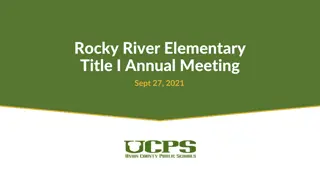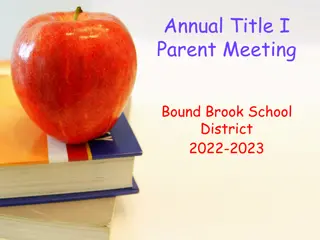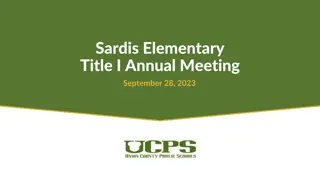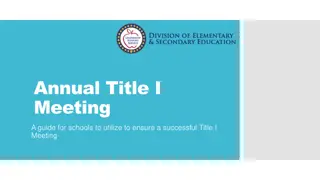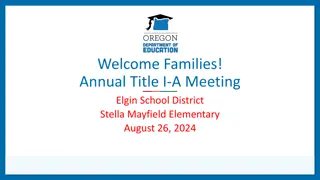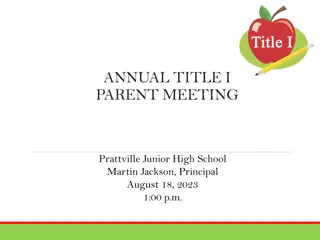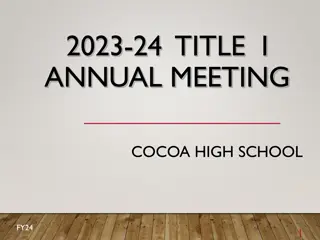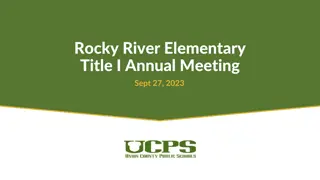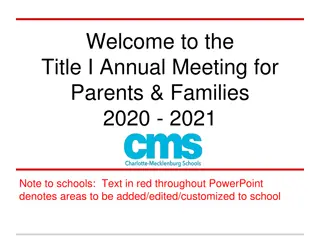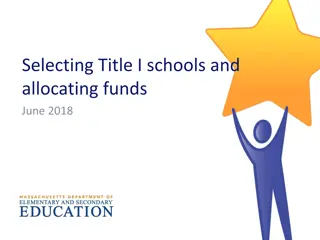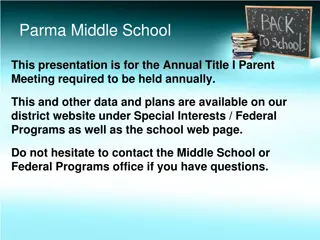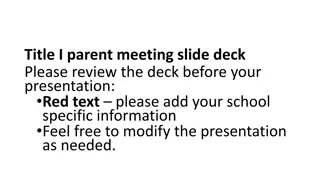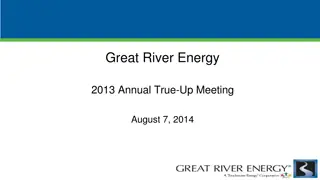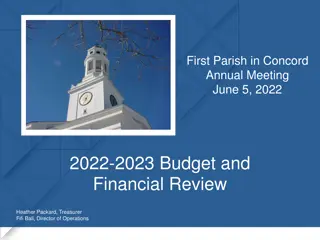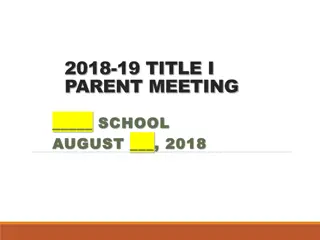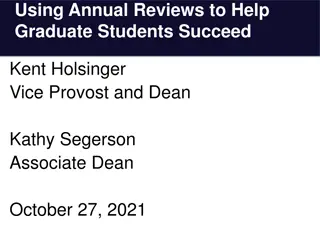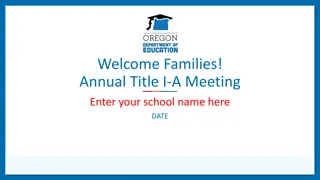Guide to Conducting Your Annual Title I Meeting
Providing a comprehensive template for districts and schools to plan and conduct their annual Title I meeting, ensuring families are informed of the school's participation in the program and their right to be involved. The template includes instructions, information, and optional slides focused on family engagement and activities to encourage conversation.
Download Presentation

Please find below an Image/Link to download the presentation.
The content on the website is provided AS IS for your information and personal use only. It may not be sold, licensed, or shared on other websites without obtaining consent from the author. Download presentation by click this link. If you encounter any issues during the download, it is possible that the publisher has removed the file from their server.
E N D
Presentation Transcript
Conducting the Annual Title I Meeting A TEMPLATE FOR DISTRICTS AND SCHOOLS
Slides 3-9 INFORMATION AND INSTRUCTIONS FOR DISTRICT AND SCHOOL USE 2
NOTE: How To Use This Template This PowerPoint template can be utilized by districts and schools as they plan and conduct their annual Title I meeting. Slides 3-9 contain instructions and information for the district/school and should not be shared with families. Slides 11-30 should be shared with families at the meeting and contain all required information. Slides 32-33 are optional, but contain information that may be useful to families. Slides 34-38 are also optional, but describe the benefits of family engagement and contain some activities that may encourage conversation and the generation of ideas. 3
NOTE: How To Use This Template Districts and schools should carefully edit and personalize slides before use with families. Make this presentation your own! Feel free to change the layout, create additional slides, and add pictures and school logos. Text within red brackets[ ]should be edited for content and deleted. 4
NOTE: How To Use This Template To access hyperlinks, please view this presentation in Slideshow mode and click on the desired link. We want our resources to be as helpful as possible for districts, and since this is the first iteration of this tool, we welcome feedback from those utilizing it. If you have questions or would like to provide feedback, please email Brinn.Obermiller@tn.gov. 5
NOTE: What is required? Each school receiving Title I, Part A funds is required to convene an annual meeting. The purpose of this meeting is to inform parents and families of the school s participation in the Title I program and the right of families to be involved. The annual meeting for schoolwide programs should include all of the parents and families of a Title I, Part A school. The annual meeting for targeted assistance programs should target and include only the families of the students identified to receive Title I, Part A services. For questions and more information about the annual Title I meeting, see our Q & A Sheet. 6
NOTE: What is required? The annual meeting should address, at a minimum: an explanation of the Title I, Part A program, including: o an explanation of the school s curriculum, o information on the forms of academic assessment used to measure student progress, and o information on the proficiency levels students are expected to meet; the Title I, Part A 1% set-aside and the families role in determining the distribution of funds; the district and school Parent and Family Engagement Policy; the School-Parent Compact; and the right of families to be involved and how they can support their child s learning. For more information on Parent and Family Engagement Policies and the School-Parent Compact, see our tools within the Parent and Family Engagement Resources folder in TDOE Resources. 7
NOTE: Meeting Format Schools may choose to format their annual meeting however they see fit, as long as all required information is covered. Promising practice in family engagement suggests that setting aside time in meetings for open discussion and collaboration with families helps to strengthen relationships between school and home. TDOE has created sample meeting protocols and agendas for the annual Title I meeting. Resources are available for: a traditional meeting format, or a facilitated discussion format. 8
NOTE: Documenting Your Work Be sure to document that the meeting took place. Maintain an annual record of: meeting invitations and announcements (flyers, emails, phone logs, etc.); sign-in sheets with date, time, name, and participant s title; detailed meeting agendas; and minutes from the meeting, including suggestions and responses of families. For samples of several of these documents, please see the Annual Title I Meeting resources within the Parent and Family Engagement Resources folder in TDOE Resources. 9
NOTE: Keys To Success Offer the meeting at least twice and at different times of day to maximize the number of families able to participate. Advertise and invite families to the meeting in at least three different ways (e.g. flyers, newsletters, website, school marquee, phone calls, emails, etc.) If necessary, hold one of the meetings in a convenient community location, such as a library, church, or apartment complex. Consider and plan for barriers to family attendance, such as transportation, meals, and childcare. Be sure to have translators and translated documents available for non- English speaking families. 10
NOTE: Keys To Success As you conduct the meeting, consider the following suggestions to help the meeting run smoothly and effectively: Begin by welcoming the families to the meeting. If there is a school administrator in attendance, they may want to conduct a brief introduction. Conduct a short icebreaker activity to get families to talk and interact with each other. Throughout the meeting, invite families to actively share their questions and thoughts. Record these on a board or flip chart. Revisit these questions and issues at the end of the workshop, and discuss whether and how they have been addressed. Avoid technical talk and education-ese. If you need to use a technical term, explain it simply the first time you use it. 11
Slides 11-29 SLIDES TO SHARE WITH FAMILIES DURING THE MEETING 12
[Insert school year] Annual Title I & Family Engagement Meeting [Insert school name] [Insert meeting date] [Insert principal s name] [Insert date of latest revision]
Why are we here? The Every Student Succeeds Act (ESSA) requires that each Title I school hold an annual meeting of Title I families in order to: inform you of your school s participation in Title I, explain the requirements of Title I, and explain your rights as parents and family members to be involved. 14
What will I learn? What is a Title I school? What are my rights? What can Title I funds be used for? How does our school use Title I funds? What is the SIP? What are our schoolwide program goals? How is parent and family engagement funded? What is the Parent and Family Engagement Policy? What is the School-Parent Compact? What curriculum does our school use? What tests will my child be taking? How can I be involved? Who can I contact for help? [Add other topics as needed, including optional slides] 15
What is a Title I school? Title I was passed in 1965 under the Elementary and Secondary Education Act (ESEA). It is the largest federal assistance program for our nation s schools. Title I schools receive extra funding (Title I dollars) from the federal government. These dollars are used to: identify students experiencing academic difficulties and provide assistance to help these students; purchase additional staff, programs, materials, and/or supplies; and conduct parent and family engagement meetings, trainings, events, and/or activities. 16
What are my rights? The families and parents of Title I students have a right, by law, to: be involved in decisions made at both the school and district level; be provided with information on your child s level of achievement on tests in reading/language arts, writing, mathematics, and science; request and receive information on the qualifications of your child s teacher and paraprofessionals who are working with your child [insert information about how families can request this information]; and request opportunities for regular meetings to formulate suggestions and to participate, as appropriate, in decisions about the education of your child. The school is required to respond to any such suggestions as soon as practicably possible. 17
What can Title I funds be used for? In general, Title I funds my be used for: smaller class sizes, additional teachers and paraprofessionals, additional training for school staff, extra time for instruction (before and/or after school programs), parent and family engagement activities, and/or a variety of supplemental teaching materials, equipment, and technology. 18
How does our school use Title I funds? In [insert school year], our school was allotted approximately $[enter amount] in Title I funding. We developed a Schoolwide Program, which means we plan to spend our funds on the following: Supplemental staff: o [List positions, not names] Programs/Materials/Supplies: o [List programs/materials/supplies] Teacher Professional Development: o [List uses] [The above is a list of options, please add and delete content as needed] 19
What is the SIP? The SIP is the School Improvement Plan. It includes: the identification of the school planning team and how they will be engaged in the planning process; a needs assessment and summary of academic and non-academic data; prioritized goals, strategies, and action steps to help address the academic and non-academic needs of students; teacher and staff professional development needs; and budgets and the coordination of resources. The school must include family representatives on our school planning team. [NOTE: While families must be involved in the SIP process, the school can determine who is involved and does not have to include all families. It is, however, best practice to have family representation on the SIP team that reflects the population and diversity of the school community.] 20
What are our schoolwide program goals? [List goals from the SIP in family-friendly language] 21
How is parent and family engagement funded? Any district with a Title I allocation exceeding $500,000 is required by law to set aside 1% of it s Title I allocation for parent and family engagement. Of that 1%, 10% may be reserved at the district for system-wide initiatives related to parent and family engagement. The remaining 90% must be allocated to all Title I schools in the district. You, as Title I parents and family members, have the right to be involved in how this money is spent. 22
How is parent and family engagement funded? In [insert school year], we received approximately $[insert amount] in parent and family engagement funding. We plan to use these funds for: Parent and Family Engagement Meeting and Events o [List meetings and events with dates] Materials/Supplies o [List materials and supplies (e.g. food for meetings, supplies for meetings & events, etc.)] [The above is a list of options, please add and delete content as needed] 23
What is a Parent and Family Engagement Policy? These plans address how the district and school will implement the parent and family engagement requirements of ESSA. Components should include: how parents and families can be involved in decision-making and activities; how parent and family engagement funds are being used; how information and training will be provided to families; and how the school will build capacity in families and staff for strong parent and family engagement. You, as a Title I parent or family member, have the right to be involved in the development of these plans. 24
What is a Parent and Family Engagement Policy? The district Parent and Family Engagement Policy can be found here: [Insert web link, and list any other places families can find the policy] The school Parent and Family Engagement Policy will be shared [insert date and method of distribution]. In addition, the policy can be found here: [Insert web link, and list any other places families can find the policy] 25
What is a School-Parent Compact? A school-parent compact is a written commitment that outlines how the entire school community teachers, families, and students will share the responsibility for improved academic achievement. The compact must describe how the school will: provide high-quality curriculum and instruction; hold parent-teacher conferences, annually in elementary schools; provide parents with reports on their child s progress; provide parents reasonable access to staff. provide parents opportunities to volunteer; and ensure regular two-way meaningful communication between family members and staff, to the extent practicable, in a language family members can understand. You, as a Title I parent or family member, have the right to be involved in the development of the compact. 26
What is a School-Parent Compact? The school-parent compact will be shared [insert date and method of distribution]. In addition, the compact can be found here: [Insert web link, and list any other places families can find the compact] 27
What curriculum does our school use? The Tennessee Academic Standards provide a common set of expectations for what students will know and be able to do at the end of a grade for each subject area. Tennessee's academic standards form the framework for everything taught at [insert school name]. For more information about Tennessee s academic standards, see: https://www.tn.gov/content/tn/education/instruction/academic-standards.html [Add content and additional slides as needed to explain the school s curriculum and provide relevant resources to families.] 28
What tests will my child be taking? [Required: add content to describe the forms of academic assessment used to measure student progress] [Required: provide information about the proficiency levels students are expected to meet] [Optional: Provide information about the current achievement levels of the school Provide a testing calendar/schedule Provide assessment resources, such as websites and assessment guides] 29
How can I be involved? We need you! Research has proven that family engagement in education has more impact on student achievement than any other factor. To get involved with the SIP, [insert information on how families can be involved: who to contact, committees to join, meetings, events, surveys, etc.] To get involved with the Parent and Family Engagement Policy, [insert information on how families can be involved: who to contact, committees to join, meetings, events, surveys, etc.] To get involved with the School Parent Compact, [insert information on how families can be involved: who to contact, committees to join, meetings, events, surveys, etc.] [Add content as needed. SIP information is optional as all families to not have to be involved.] 30
How can I be involved? [Use the next few slides to begin a discussion about other ways families can be involved in the education of their student. Examples may include, but are not limited to: encouraging attendance; monitoring grades and schoolwork on an online system or portal; attending family events and meetings (provide specific dates when possible); observing or volunteering in classrooms; joining family groups and committees (e.g., PTA/PTO, advisory councils, etc.); and reading school/classroom newsletters or websites and that contain examples of learning activities families can do with students at home.] [The school may choose to include other examples of family engagement tailored to their community] 31
How can I be involved? [Delete slide or add content as appropriate] 32
Who can I contact for help? For general questions, call the front office at: [insert phone number] To reach the principal, [add name], call: [insert phone number] To reach the school counselor, [add name], call: [insert phone number] To reach our family liaison, [add name], call: [insert phone number] To reach your child s teacher, call the front office or view our staff directory at: [insert website] [Delete and add contacts as needed] 33
WE JUST WANT TO SAY THANK YOU! 34
Slides 32-39 OPTIONAL SLIDES 35
What is our schools designation status? In accordance with Tennessee s accountability system, the Tennessee Department of Education (TDOE) determines designations for all public schools. Designations include: Reward Schools - Reward schools include the top 10 percent of schools. Priority Schools - Priority schools are the 5 percent of schools with the lowest success rates (using up to three years of data) in the state. Focus Schools - Focus schools are the 10 percent of schools identified through one of three pathways: o Graduation Rate Pathway - High schools with an average graduation rate of less than 60 percent. o Subgroup Pathway - Any subgroup with a success rate of less than ten percent. o Gap Pathway - Schools with the largest gaps between selected groups. [Include information on the schools designation status] 36
What is the State Report Card? TDOE releases an annual Report Card on Tennessee schools. This report displays state-, district-, and school-level data for each school year. It includes information on demographics, achievement, academic growth, attendance, graduation rate and more. You can view the data statewide, or you can choose a specific district or school. You can view the report card here: https://www.measuretn.gov:444/ReportCard/#/ 37
What is parent and family engagement? Family engagement is a shared responsibility in which schools and other community agencies and organizations are committed to reaching out to engage families in meaningful ways and in which families are committed to actively supporting their children's learning and development. Family engagement is continuousacross a child s life and entails enduring commitment but changing family roles as children mature into young adulthood. Effective family engagement cuts across and reinforces learning in the multiple settings where children learn at home, in pre-kindergarten programs, in school, in after-school programs, in faith-based institutions, and in the community. Source: The National Association for Family, School, and Community Engagement (https://nafsce.site-ym.com/page/definition) 38
What is parent and family engagement? Through effective communication with parents, teachers can have the greatest impact on their day-to-day success with students. With parents on their side, teachers can more effectively manage most academic and behavioral issues that arise. When the most important adults in a child s life are working together, students benefit enormously. Lee and Marleen Canter Source: Parents on your Side: A Teacher s Guide to Creating Positive Relationships with Parents 39
Table Activity Partner with those at your table to discuss the following questions: What form of communication works best for you? (e.g. phone calls, texts, emails, notes, face-to-face, etc.) What kinds of information do you most want to receive from the school? What might the school do differently to improve communication between school and home? [Add other discussion questions as needed] Record your group s thoughts on chart paper. Be prepared to share! 40
What are the benefits of family engagement? For Schools and Teachers: For students: For Parents and Families: Improved teacher and staff morale Higher grades and test scores More confidence and trust in the school Better attendance Higher ratings of schools and teachers by families Increased confidence in their parenting skills More positive attitudes and better behavior More support from families Creates a home environment that encourages learning Higher graduation rates Higher student achievement Greater enrollment in postsecondary education Encourages families to form stronger relationships with teachers and other families Increased and improved relationships within the community 41
Table Activity Partner with those at your table to discuss the following questions: What are the strengths of your school and community? In what ways are your school, families, and community working together effectively? What might schools, families, and the community do differently to work together more successfully? [Add other discussion questions as needed] Record your group s thoughts on chart paper. Be prepared to share! 42



